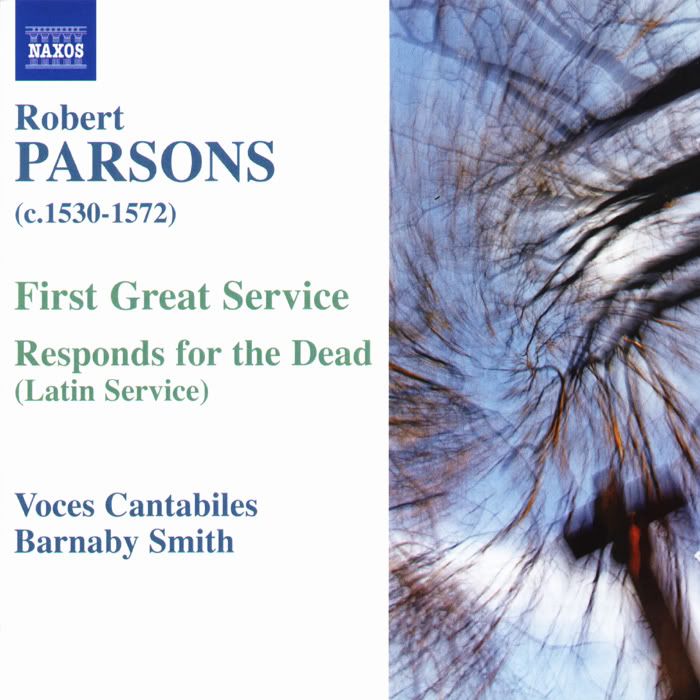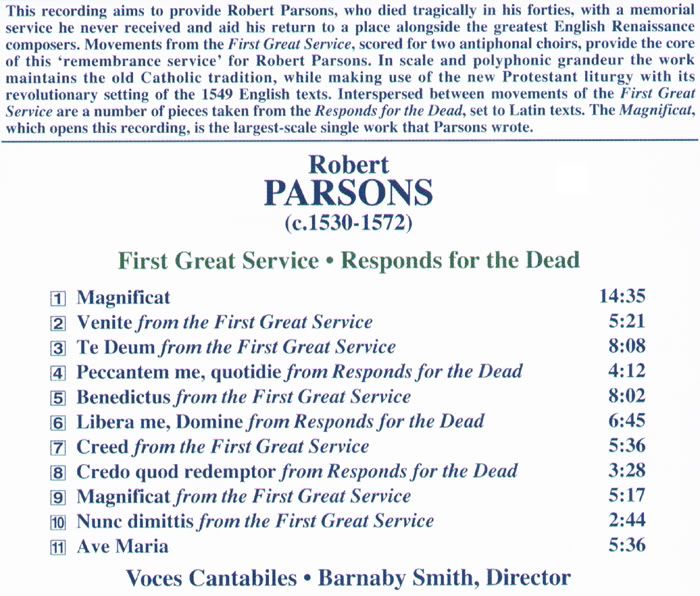 |
| NetLab · Rules · Torrent Tracker · Have a problem? · Eng/Rus |
 Help Help
 Search Search
 Members Members
 Gallery Gallery
 Calendar Calendar
|
| Welcome Guest ( Log In | Register | Validation ) | Resend Validation Email |
|
Posted: 03-01-2009, 00:15
(post 1, #872819)
|
||||||||||||||||||
|
Pro Member Group: Members Posts: 695 Warn:0% |
Robert Parsons (1530 - 1572) First Great Service, Responds for the Dead Label: Naxos, 8.570451 Year: 2007 Performers: Voces Cantabiles Barnaby Smith - conductor Robert Parsons is something of a forgotten man of English Renaissance music, and annotator and conductor Barnaby Smith discusses in the booklet a startling reason why: Parsons fell into the River Trent and drowned in 1572, and there was "upset and suspicion surrounding his death" - apparently to the point where the choristers of the Chapel Royal uneasily began to avoid his music. If anyone is inspired to write a mystery novel yet, know that you'll have an additional selling point to use when your agent tries to get your book turned into a movie: Parsons' music is an attractively varied lot that reflects its time and would offer all kinds of ideas to an enterprising director. Parsons lived from around 1530 to 1572, and his career thus coincided with the musical beginnings of the Reformation in England. The program is structured as an imagined musical requiem for Parsons that he never had in his own time - not an actual service for the dead but a collection of Parsons' works that both represents his output and contains some funeral music - a group of Latin responds (responsories) for the dead. Both Latin- and English-language pieces are included, and the differences between them contribute part of the interest of the program. The opening Magnificat, in Latin, is a remarkably varied piece of High Renaissance polyphony in terms of texture - so much so that Parsons almost seems to ignore the Renaissance homogeneous sound idea. Something always seems to be happening in this piece: voice pairs and trios and quartets trade off, with a different grouping each time, and canonic passages provide a sharp contrast with sections that have the quality of free fantasy. The English-language First Great Service is soberer in comparison, but doesn't have the spare quality of Tallis' Anglican anthems - one senses that Parsons was trying to find a middle ground between the big polyphonic style and the Protestant spirit. The young mixed-gender singers of Smith's Voces Cantabiles deliver a fresh, accurate take on the classic British cathedral sound, and really the only disagreeable experiences here result from Naxos' having cut corners; the First Great Service was recorded in a different church from the rest of the music (with unsettling results), the cheesy cover photo is from an Internet stock collection, and listeners unfamiliar with the Book of Common Prayer will have to look it up on the Internet - no texts are included. These irritants merely blemish a fine recording that will fill a hole in many a Renaissance or English music collection. Voces Cantabiles have enthusiastically and carefully reached into a tightly tied sack and pulled out some jewels. Next to nothing is known about Robert Parsons. He was born around 1530. That makes him almost the same generation as Byrd, who succeeded Parsons at the Chapel Royal to which the latter was appointed in 1563. He died by drowning in the River Trent in 1572. It has been suggested that Parsons’ unusual death may have been responsible for fellow musicians and associates turning their backs on his music immediately after the traumatic event; and that this neglect somehow snowballed. We know that not all of Parson’s music has survived. He presumably wrote a much larger corpus of instrumental music while at the Chapel Royal than has survived. Indeed there are only two current CDs containing Parsons’ music; each shares performances of his Ave Maria (included here too) with other anthologies. So this release with almost 70 minutes of touching, moving and unself-consciously beautiful music performed by the accomplished ensemble, Voces Cantabiles, is particularly welcome. All the more so since Parsons broke new compositional ground – and not just because he lived at a time of significant change in musical thinking and practice. His choral writing displays some of the breadth of Taverner and Tallis, say, and much of their command and sense of direction with the way in which words meet music. The texts - not included in the Naxos booklet - here are both Latin and English. The style is both driven and mildly decorative ... as at the end of the Creed (tr.7) where a nevertheless restrained melisma stands out for what it adds to an otherwise driven progression of musical ideas. This – rightly – suggests that Parsons lacks the more personally-expressed depth of his more illustrious contemporaries. Yet his music has real beauty and is pleasantly compelling. His lines are clear, clean and inspiring; his textures never dense or obscure. This reflects the new emphasis on plainness and purely English liturgical writing as required by the publication in 1549 of Cranmer’s ‘Book of Common Prayer’. For all that icon of the English Reformation’s implied simplicity of purpose and tenor, Parsons’ corresponding music lacks nothing in style or detail. It contains some almost experimental harmonies, which will delight as one comes to know the other aspects of his choral writing. It should be noted that the ‘First Great Service’, parts of which occupy about half this well-recorded CD, was one of the first settings of the liturgy to comply with the new and revolutionary requirements for composition in English. It’s music for two five to eight-part antiphonal choirs. In that the ‘First Great Service’ was also one of the first such services to be unified throughout its movements, a recording which respects that continuity would be welcome one day: this does not – movements from the ‘Responds for the Dead’ are interspersed. These are striking pieces from the ‘Burial Service’. The intention of this CD’s producers has been to honour Parsons in ways that probably didn’t happen in the sixteenth century. Very fitting. Parsons’ Magnificat is his largest extant composition. It’s scored for six-voice choir and alternates plainsong and polyphony in new and radical ways; and in ways that differ movement from movement yet at the same time acknowledge the by then century old musical format with great skill. This is a bit of a gem that repays very careful study. If there were a criticism of the way Barnaby Smith and Voces Cantabiles perform this highly effective, melodious and gracious music, it would be that they do not always take the time to savour some of the more glowing passages. Though they do bring out the music’s warmth – listen to the end of the Nunc dimittis, and for that matter of the Ave Maria. But greater revelation of the contrasts which Parsons achieved between light and darkness, joy and pain would have made the interpretation more effective still. This CD achieves much. It draws attention to an unfairly neglected English composer of what is perhaps the tradition’s richest period. It suggests that Robert Parsons can hold his own with all but the greatest practitioners of the time. It conveys a clear and striking sense of his skills, sensitivity both to traditions and to innovations from and by the clergy at the watershed of the Reformation. It implicitly highlights the innovative writing in which Parsons appeared strikingly comfortable. It presents the variety of techniques of which Parsons was capable - and on which he thrived. And it offers us a serving of some truly lovely, delicate and yet potent choral singing. A very welcome selection of choral polyphony from the start of the Reformation. Voces Cantabiles have enthusiastically and carefully reached into a tightly tied sack and pulled out some jewels - without a whiff of mustiness; and with the promise of greater sparkle to come. Mark Sealey, MusicWeb International This recording aims to provide Robert Parsons, who died tragically in his forties, with a memorial service he never received and aid his return to a place alongside the greatest English Renaissance composers. Movements from the First Great Service, scored for two antiphonal choirs, provide the core of this ‘remembrance service’ for Robert Parsons. In scale and polyphonic grandeur the work maintains the old Catholic tradition, while making use of the new Protestant liturgy with its revolutionary setting of the 1549 English texts. Interspersed between movements of the First Great Service are a number of pieces taken from the Responds for the Dead, set to Latin texts. The Magnificat, which opens this recording, is the largest-scale single work that Parsons wrote. Tracklist: 01. Ave Maria 02. Magnificat 03. First Service in F major "Great" - Venite 04. First Service in F major "Great" - Te Deum 05. Responds for the Dead - Peccantem me, quotidie 06. First Service in F major "Great": Benedictus 07. Responds for the Dead - Libera me 08. First Service in F major "Great" - Credo 09. First Service in F major "Great" - Magnificat 10. First Service in F major "Great" - Nunc dimittis 11. Responds for the Dead - Credo   LOG
This post has been edited by kgkk on 03-01-2009, 00:19 |
||||||||||||||||||
|
|||||||||||||||||||


Powered by Invision Power Board v1.3.1 Final.

